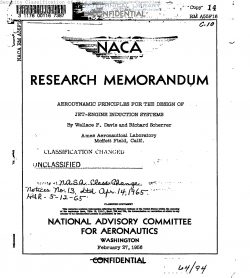naca-rm-a55f16
- Version
- 108 Downloads
- 12.13 MB File Size
- 1 File Count
- October 9, 2017 Create Date
- October 9, 2017 Last Updated
National Advisory Committee for Aeronautics, Research Memorandum - Aerodynamic Principles for the Design of Jet Engine Induction Systems

An air-induction system conveys air from the atmosphere to the
engine of an aircraft. Its purpose is to supply, under all flight con—
ditions, the air needed. for best operation of the engine with the least
disturbance to the external flow. In other words, to avoid penalties in
engine size, weight, and fuel consumption, an induction system must supply
air at the maximum pressure and with the least drag and adverse inter-
ference possible. The flow to the engine must be sufficiently uniform
and steady to maintain engine performance and to avoid vibration and
structural failure. The significance of the air—ifiuction system in
high-speed—aircraft design. has been well illustrated by Sulkin in refer—
ence 1. It is shown that for fighter aircraft flying at Mach numbers less
than about 1.1, the pressure losses through a typical normal-shock inlet
cause a loss in engine thrust that is equivalent to less than 10 percent
of the wing drag; whereas, at a Mach mmber of 1.6, these pressure losses
reduce the engine thrust force by an amount equal to the wing drag.
A sizable quantity of research has been directed toward finding
solutions to the problems of air-induction systems, particularly in the
Mach number range from O to 2; but the results have not been consolidated
into an organized group of design principles. EIchemann and Weber have
written a textbook on propulsion (ref. 2) and present some discussion of
air induction. However , further consolidation of information is required,
particularly for supersonic aircraft. It is the purpose of this report
to assemble principles of. induction-system design for flight to a Mach
number of 2 and to use existing data. to show the censequences of compro-
mising them. In order to accomplish this task it was necessary to make
an extensive search of existing literature on air-induction systems. A
bibliography based on this search is appended to the present report.
The bibliography lists reports published since 19148 and thus extends the
bibliography of reference 3. The authors acknowledge with gratitude the
assistance given by Mr. Enmet A. Mossman, Mr. Forrest E. Gowen, and
Mr. Warren E. Anderson in carrying out the literature search and in making
other contributions to this report.
| File | Action |
|---|---|
| naca-rm-a55f16 Aerodynamic Principles for the Design of Jet Engine Induction Systems.pdf | Download |
Comment On This Post